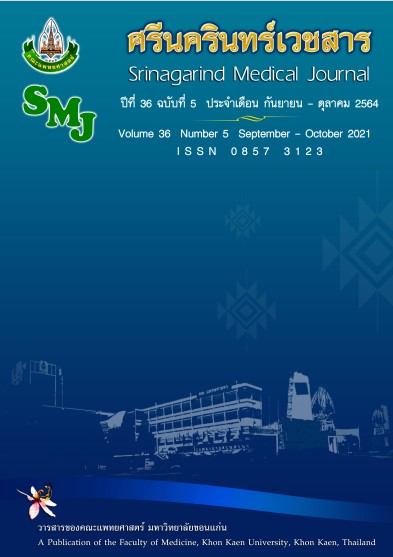การวิเคราะห์ลักษณะของมะเร็งตับในระยะตับและทางเดินน้ำดีของสาร gadoxetate disodium
Abstract
Analysis of Hepatobiliary Phase of Gadoxetate Disodium Characteristics of Hepatocellular Carcinoma
Julaluck Promsorn1, Mareenis Paholpaks1, Nittaya Chamadol1, Panita Limpawattana2
1Department of Radiology, Faculty of Medicine, Khon Kaen University, Thailand
2 Department of Internal Medicine, Faculty of Medicine, Khon Kaen University, Thailand
Author for correspondence:
Dr Julaluck Promsorn, Department of Radiology, Faculty of Medicine, Khon Kaen University, Khon Kaen, 40002, THAILAND, Phone: 66-868504753 Fax: 66-43348389, Email:pjulaluck@kku.ac.th
วัตถุประสงค์: เพื่อกำหนดลักษณะของก้อนมะเร็งตับ และศึกษาปัจจัยที่มีความสัมพันธ์กับลักษณะของมะเร็งตับ ในระยะตับและทางเดินน้ำดีหลังการฉีดสาร gadoxetate disodium
วิธีศึกษา: เป็นการศึกษาย้อนหลังของคนไข้ที่ได้รับการตรวจวินิจฉัยโรคด้วยคลื่นแม่เหล็กไฟฟ้า ของผู้ป่วยที่เป็นโรคมะเร็งตับและได้ฉีดสาร gadoxetate disodium ที่โรงพยาบาลศรีนครินทร์ มหวิทยาลัยขอนแก่น ระหว่าง เดือน เมษายน 2552 ถึง ตุลาคม 2554 ข้อมูลประชากร วิเคราะห์โดยใช้สถิติเชิงพรรณนา และใช้การถดถอยโลจิสติกที่ไม่แปรผันเพื่อวิเคราะห์ผลลัพธ์ของการศึกษา
ผลการศึกษา: จากก้อนมะเร็งตับทั้งหมด 45 ก้อน พบลักษณะ hypointensit 39 ก้อน (ร้อยละ 87.2) พบลักษณะ hyperintense 6 ก้อน ซึ่ง 1 ก้อนพบ homogenous hyperintensity และ hypointense บริวณขอบ และ 5 ก้อนพบ hyperintensity และ hypointense ตรงขอบร่วมกับจุด hypointense ในก้อน ของ ตับและทางเดินน้ำดีหลังการฉีดสาร gadoxetate disodium พบว่าค่า ALT ที่มากกว่า 100 ขึ้นไปสัมพันธ์กับลักษณะก้อนมะเร็งตับที่มีลักษณะ hyperintensity และ hypointense ตรงขอบร่วมกับจุด hypointense ในก้อน ส่วน AFP ขนาดก้อน Child-Puge ไม่มีความสันพันธ์กับลักษณะ ของก้อนมะเร็งตับ ในระยะ ตับและทางเดินน้ำดีหลังการฉีดสาร gadoxetate disodium
สรุป: ก้อนมะเร็งตับส่วนใหญ่ให้ลักษณะ hypointensity และค่า ALT ที่มากกว่า 100 ขึ้นไปสัมพันธ์กับลักษณะก้อนมะเร็งตับที่มีลักษณะ hyperintensity และ hypointense ตรงขอบร่วมกับจุด hypointense ในก้อนในระยะตับและทางเดินน้ำดีหลังการฉีดสาร gadoxetate disodium
คำสำคัญ: มะเร็งตับ; คลื่นแม่เหล็กไฟฟ้า; การทำงานของตับ; ทางเดินน้ำดี; เอนไซม์ของตับ
Objective: To characterize the patterns of hepatocellular carcinoma (HCC) nodules and to determine the factors correlated with the hepatobiliary phase characteristics of the HCC nodules using gadoxetate disodium-enhanced hepatobiliary phase MRI.
Methods: A retrospective review of medical records and dynamic imaging using gadoxetate disodium-enhance MRI of patients with HCC at Srinagarind Hospital, Khon Kaen University, Thailand between April 2011 and October 2013 was performed. Demographic data were analyzed using descriptive statistics. Univariate logistic regressions were used to analyze the outcomes.
Results: Forty-five HCC were eligible for this study; the majority of the HCC patients (39 cases; 87.2%) had hypointensity of HCC nodules in the hepatobiliary phase. Of the 6 patients with hyperintense HCC nodules, 1 showed homogenous hyperintensity with hypointense rims and 5 showed hyperintensity with hypointense rims and focal defects in the hepatobiliary phase. Only ALT ³100 U/L was significantly associated with homogeneous hyperintensity and hyperintense rims with focal defects (p=0.008). There was no association between AFP level, size of the HCC nodules, and the Child-Puge classification with the pattern in the hepatobiliary phase.
Conclusion: In the gadoxetate disodium-enhanced hepatobiliary phase MRI images, the hypointense pattern was the most commonly seen in HCC nodules with typical vascular patterns. For HCC appearing as a hyperintense nodule in the hepatobiliary phase, a hypointense rim with a focal defect pattern could be observed. The patients with HCC and ALT ³100 U/L were associated with the hyperintense pattern of the hepatobiliary phase using gadoxetate disodium.
Keywords: Gadoxetate disodium; Hepatocellular carcinoma (HCC); Magnetic resonance imaging (MRI); Child-Puge; Alanine aminotransferase (ALT); Aspartate aminotransferase (AST); Alpha-fetoprotein (AFP)


